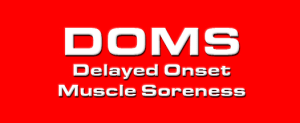
The delayed soreness of DOMS is generally at its worst within the first 2 days following the activity and subsides over the next few days. This sort of muscle pain is not quite the same as the muscle pain or fatigue you experience during exercise.

Delayed onset muscle soreness (DOMS) describes a phenomenon of muscle pain, muscle soreness or muscle stiffness that is felt 12-48 hours after exercise, particularly at the beginning of a new exercise program, after a change in sports activities, or after a dramatic increase in the duration or intensity of exercise.
This muscle pain is a normal response to unusual exertion and is part of an adaptation process that leads to greater stamina and strength as the muscles recover and build hypertrophy.
This sort of muscle pain is not quite the same as the muscle pain or fatigue you experience during exercise. This delayed pain is also very different than the acute, sudden pain of and injury such as muscle strains and sprains, which is marked by an abrupt, specific and sudden pain that occurs during activity and often causes swelling or bruising.
The delayed soreness of DOMS is generally at its worst within the first 2 days following the activity and subsides over the next few days.
Delayed onset muscle soreness is quite common and quite annoying, particularly for those beginning an exercise program or adding new activities. A beginning exerciser who bikes 10 miles, followed by push-ups and sit-ups is likely to experience muscle pain and soreness in the next day or two.
Delayed Onset Muscle Soreness – Causes
Delayed onset muscle soreness is thought to be a result of microscopic tearing of the muscle fibers. The amount of tearing (and soreness) depends on how hard and how long you exercise and what type of exercise you do. Any movement you aren’t used to can lead to DOMS, but eccentric muscle contractions (movements that cause muscle to forcefully contract while it lengthens) seem to cause the most soreness.
Examples of eccentric muscle contractions include going down stairs, running downhill, lowering weights and the downward motion of squats and push-ups. In addition to small muscle tears there can be associated with swelling in a muscle which may contribute to soreness.
Delayed Onset Muscle Soreness – Treatment
There is no one simple way to treat delayed onset muscle soreness. In fact, there has been an ongoing debate about both the cause and treatment of DOMS. In the past, gentle stretching was one of the recommended ways to reduce exercise related muscle soreness, but a study by Australian researchers published in 2007 found that stretching is not effective in avoiding muscle soreness.
So does anything work to reduce delayed-onset muscle soreness? Nothing is proven 100 percent effective, but some people have found the following advice helpful, but it’s best for an individual to try a few things to see what works for them. Ultimately, best advice for treating DOMS is to prevent it in the first place.
Tips for Dealing With Muscle Soreness After Exercise
If you do find yourself sore after a tough workout or competition, try these methods to deal with your discomfort. Although not all are backed up with research, many athletes report success with some of the following methods. These methods include BCAA’s, stretching session, myofascial release, and consume protein.
Methods:
- Muscle Multiplier is perfect before, after, and during training, and they help build and preserves muscle. Not only are Essential Amino Acids are widely used, this product has been patented to help in restore muscle tissue and prolongs the intensity and recovery from your next workout.
- Stretching helps break the cycle and reduces the soreness of muscle stiffness. Stretching is a great way to help provide relief. We offer stretching sessions at CNU Fit and you can book an appointment using this link: www.cnufit.com/stretching.
- Adequate protein consumption is not only essential for building muscle mass, but ingesting protein during and after exercise has also been shown to decrease post-exercise muscle damage. Protein comes from a variety of sources. You might prefer getting your protein from solid foods (such as meat) or supplements (i.e. powder, bars, liquids, etc.). You can also stop by our store and purchase ISO-100.


